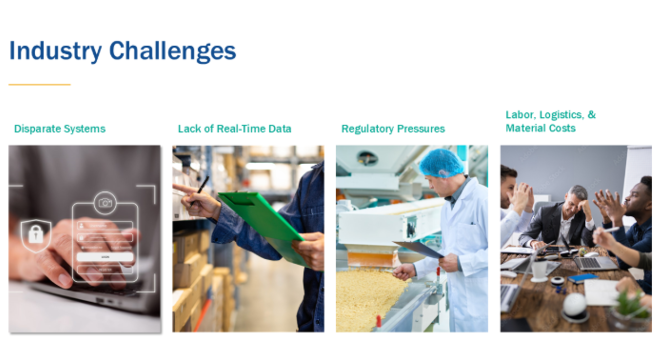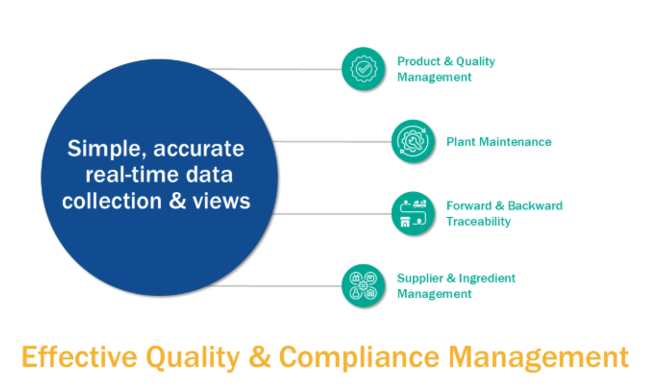OverDate: Thursday, October 17th | 1:00 PM ET
Complimentary Webinar
How can businesses in the food and beverage industry enhance productivity, profitability, and bring products to market more quickly – while overcoming market pressures and complying with increasingly stringent rules and regulations?
These questions and more were the focus of a recent Datacor-sponsored webinar hosted by Food Processing. The hour-long session, titled Overcoming Complexity in the Food & Beverage Industry, considered how businesses incorporating technology, data collection, and automation can enhance their operations and workflows.
The webinar, held in August and still available to watch online, considered how food processors and manufacturers are under increasing pressure to bring product to market faster and cheaper while having to navigate an influx of regulations from The United States Department of Agriculture (USDA) and U.S. Food and Drug Administration (FDA).
To examine these challenges and the potential opportunities, host Dave Fusaro, Editor-in-Chief at Food Processing, was joined by Datacor’s Teresa Finn, Product Manager, Food and Beverage; Amanda Haley, Director, Solutions Engineering; and Andrew Shield, Food and Beverage Strategy.
Leading the discussion, Finn said that by leveraging technology and data, companies are not only able to ensure compliance, but could also cut costs, boost sales, and improve customer relationships.
“What we see so often is that companies will start off with an accounting system, something that manages their financials, and then they’ll bolt on some additional systems to manage their production or warehouse and inventory,” she said during the session.
The result is reliance on very different systems that don’t communicate effectively, making it all too easy for potentially costly mistakes to be made.

Relatively simple tasks, such as staying on top of inventories or being able to check whether ingredients are available, are made extremely difficult without access to real time data, she continued.
“Ingredients aren’t consumed in real time, and the inventory isn’t added to your system in real time for the products that you produce,” said Finn. “This leaves your sales and operations team having to manage everything manually because they have to talk amongst themselves to see what’s going out, when it’s going out, and if they’re meeting their customers’ needs.”
All too often, that means mistakes are made. Lot numbers can easily be transposed or entered incorrectly, and sales and operations teams are lacking full visibility when it comes to what ingredients are coming in, what’s going out, when, and to who.
Combined with the prevailing regulatory pressures facing the market, businesses in this critically important segment will find it tough to meet customers’ expectations without utilizing technology and software.
“The way that you can protect your ability to meet those customer expectations is by investing in your most important asset, which is your own resources,” says Finn. “If you can provide them with simple repeatable processes, that helps them tremendously.”
Automating processes throughout your business – whether that’s receiving, shipping, production, or maintenance – results in fewer errors, less risk, and reduced costs.
By leveraging technology and combining sales, production, inventory, shipping, and quality information all in one system, teams have key information at their fingertips and can use it to understand anything from the true transactional cost for a customer to how fluctuating ingredient prices will likely affect business strategy and decision making.
“Digital data collection and process automation is a fundamental part of that,” continued Finn.
Capturing data via barcode scanning out on the factory floor means information can be easily managed and shared across an organization. Technology can be used to better utilize data for inventory management, Accounts Payable (AP) automation, and sales order automation to streamline workflows and prevent back-office errors.
Harnessing data effectively also means issues can be identified and caught early, minimizing downtime and recalls.
Another particular benefit in the food and beverage segment is forward and backward traceability, noted Finn, particularly with the regulatory bodies now requiring electronic data reports.
It also helps to ensure you have all the right specifications, meet quality requirements, as well as for compliance. Being able to access data and draw on it for root cause analysis enables continuous improvement and makes audits easier to manage.
Looking forward, with the advent of artificial intelligence – or AI, collected data will prove even more invaluable, allowing for better forecasting and enabling users to closely monitor and predict consumer trends and price movement, she concluded.

Webinar highlights:
To watch the full webinar, visit https://datacorinc.wistia.com/medias/x8x5n6dcla.
Below are some of the key takeaways from the session:
2:07 – Challenges and opportunities (Teresa Finn, Product Manager, ERP, Datacor)
11:10 – “A single source of truth”
13:07 – Accurate data is critical
16:08 – Forward and backward traceability
17:30 – Leverage information with artificial intelligence
18:35 – Product demo (Amanda Haley, Director of Solutions Engineering, Datacor)
43:28 – About Datacor (Andrew Shield, Food and Beverage Strategy)


